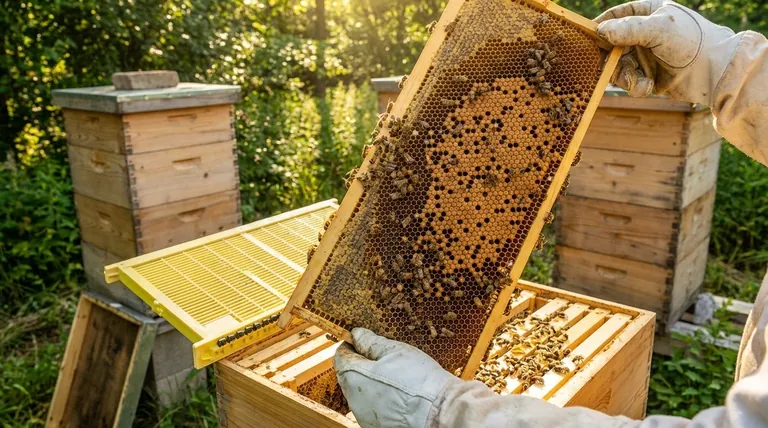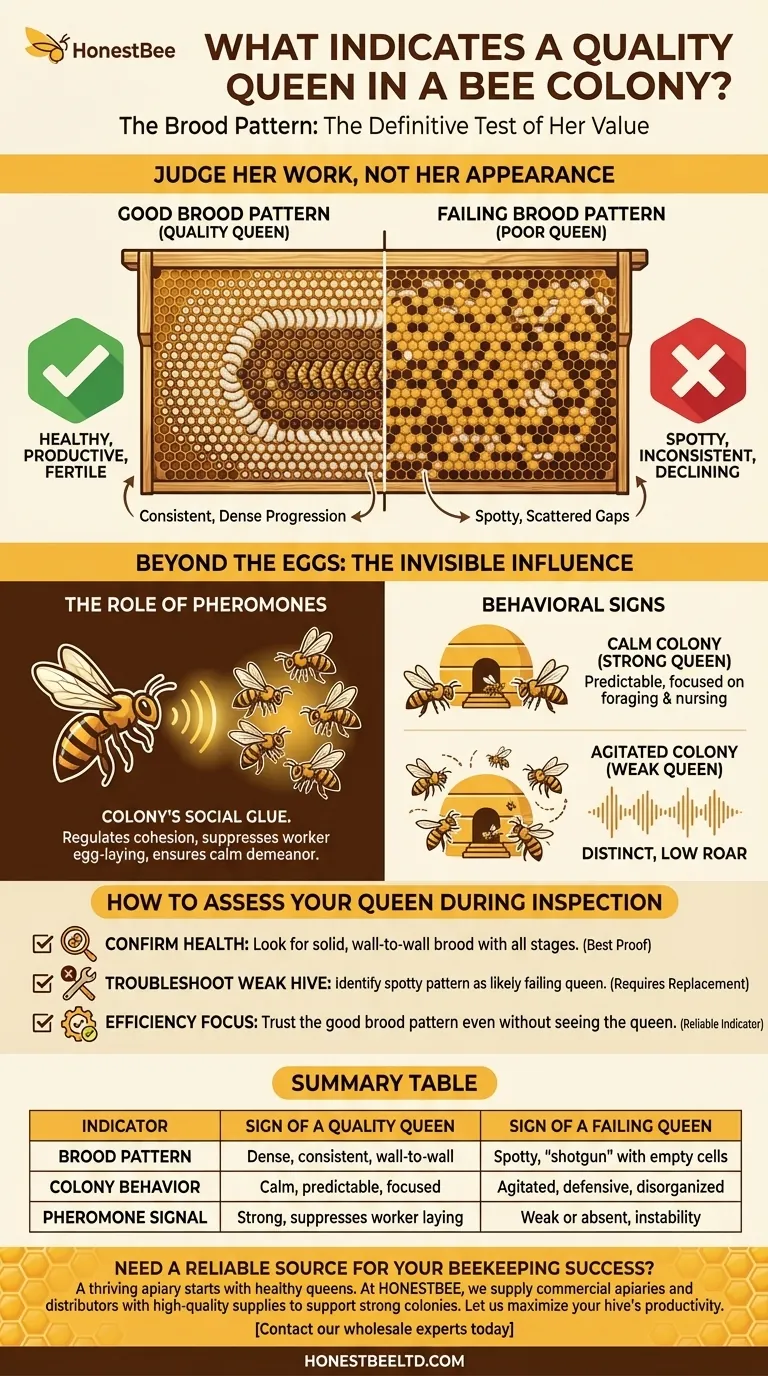The single most important indicator of a quality queen bee is her brood pattern. While a beekeeper might want to judge a queen by her size or appearance, the true test of her value is the evidence she leaves behind. A healthy, productive queen will create a dense, consistent pattern of eggs, larvae, and pupae across the frame.
The quality of a queen is not determined by how she looks, but by the results she produces. The ultimate sign of her health and fertility is a solid, uninterrupted "brood pattern," which is the direct measure of her ability to sustain and grow the colony.

Why the Brood Pattern is the Definitive Test
A queen has two primary jobs: laying eggs and producing the pheromones that hold the colony together. The brood pattern is the most direct and reliable visual of how well she is performing the first, and most critical, of these tasks.
What a "Good" Pattern Looks Like
A high-quality queen lays eggs in a methodical, organized fashion. On a frame, you should see a solid, concentrated area of brood where nearly every cell is filled.
This pattern should look like a well-laid carpet, with eggs, developing larvae, and capped pupae all tightly grouped. You will see a clear progression, often with the youngest brood at the edges and older, capped brood in the center.
What a "Failing" Pattern Looks Like
A failing or poorly-mated queen leaves a much different signature. You will see a spotty or "shotgun" brood pattern.
This is characterized by many empty cells scattered among the capped brood. It indicates the queen's fertility is declining, she is laying unfertilized eggs that workers are removing, or she is simply inconsistent.
Beyond the Eggs: The Queen's Invisible Influence
While the brood pattern is the key visual cue, a queen's pheromones are equally critical for a healthy colony. You can't see them, but you can see their effect on the hive's behavior.
The Role of Pheromones
The queen produces a unique chemical scent, or pheromone, that serves as the colony's social glue. This scent signals to all other bees that a healthy, laying queen is present.
Her pheromones regulate colony cohesion, suppress the ovarian development of worker bees (preventing them from laying eggs), and contribute to the overall calm and productive demeanor of the hive.
Behavioral Signs of a Healthy Colony
A colony with a strong queen is typically calm and predictable during an inspection. The bees are focused on their tasks of foraging, nursing brood, and building comb.
In contrast, a queenless colony or one with a failing queen often becomes agitated, defensive, and "disorganized." The sound of the hive may even change to a distinct, low roar.
Common Pitfalls and Considerations
Assessing a queen requires context. A single observation might not tell the whole story, so it's important to avoid common misinterpretations.
A Spotty Pattern Isn't Always a Death Sentence
A poor brood pattern can sometimes be caused by external factors. A sudden lack of pollen or nectar can cause the queen to slow her laying, creating temporary gaps. Always consider the environmental conditions before condemning your queen.
A New Queen Needs Time
A newly introduced or newly-mated queen needs time to get into her full laying rhythm. Her initial patterns may be small or slightly inconsistent. It is wise to give her a few weeks to establish herself before making a final judgment.
Judge Her Work, Not Her Appearance
It is a common mistake for new beekeepers to spend too much time trying to find the queen herself. While seeing her is reassuring, it tells you very little about her performance. Trust the brood pattern above all else.
How to Assess Your Queen During an Inspection
When you inspect your hive, your goal is to read the story the frames are telling you. Use this simple framework to make an accurate assessment.
- If your primary focus is confirming queen health: Look for a solid, wall-to-wall brood pattern with all stages of development present; this is the best proof your queen is performing well.
- If your primary focus is troubleshooting a weak hive: Identify a spotty, inconsistent brood pattern as the most likely indicator of a failing queen requiring replacement.
- If your primary focus is efficiency: Trust the evidence of a good brood pattern even if you cannot find the queen; her work is a more reliable indicator than a fleeting visual confirmation.
Ultimately, a quality queen proves her worth through the health, temperament, and productivity of the colony she builds.
Summary Table:
| Indicator | Sign of a Quality Queen | Sign of a Failing Queen |
|---|---|---|
| Brood Pattern | Dense, consistent, wall-to-wall | Spotty, "shotgun" with many empty cells |
| Colony Behavior | Calm, predictable, focused on tasks | Agitated, defensive, disorganized |
| Pheromone Signal | Strong, suppresses worker egg-laying | Weak or absent, leading to hive instability |
Need a reliable source for your beekeeping success? A thriving apiary starts with healthy, productive queens. At HONESTBEE, we supply commercial apiaries and beekeeping equipment distributors with the high-quality supplies and equipment needed to support strong colonies. Let us help you maximize your hive's productivity. Contact our wholesale experts today to discuss your needs.
Visual Guide

Related Products
- No Grafting Queen Rearing Kit: System for Royal Jelly Production and Queen Rearing
- Jenter Queen Rearing Kit Complete Set for Bee Breeding
- JZBZ Langstroth Queen Rearing Frame for Beekeeping
- Professional Bamboo Queen Isolation Cage
- Wood and Mesh Push-In Queen Cage
People Also Ask
- What are the signs that indicate a colony needs requeening? Protect Your Hive's Health and Productivity
- What are the two main categories of queen rearing methods? Grafting vs. Non-Grafting Explained
- What should be done once eggs are present in the comb box? A Guide to Maximizing Queen Rearing Success
- What are the stages involved in queen raising? A Guide to Controlled, High-Quality Queen Production
- How can beekeepers start a honey bee breeding program? Build a Superior, Resilient Apiary



















